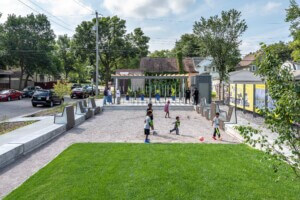The Aluminaire House is homeless once again. Built in 1931 for the Allied Arts and Industry and Architectural League Exhibition, the house introduced prefabricated design methods espoused by Le Corbusier to an American audience. Corbu disciple Albert Frey designed the house with A. Lawrence Kocher, onetime editor at Architectural Record. After more than 100,000 visitors passed through, the architect Wallace Harrision snapped it up and placed it on his estate to be used as guest house. The building later was featured in Hitchcock and Johnson’s 1932 MoMA exhibition and in their book The International Style. Eventually, the house came under the care of the New York Institute of Technology and onto their former Islip campus. Last month, the house was dismantled once again and handed over to the newly formed Aluminaire House Foundation, run by architects Frances Campani and Michael Schwarting of Campani and Schwarting Architects.
It would seem that the repetitious reassembly and dismantling has inadvertently supported the modular mass production theories of the house’s designers. With that in mind, the foundation is looking for a low-rise high-density site on the outskirts of New York City where the house might not necessarily be an aesthetic fit, but a theoretical one. In a telephone interview Schwarting said that that a place like Forrest Hills Queens, where Kocher once lived, might be an interesting notion, in so much as this too was middle class housing for a planned community. The group has also identified a site in Sunnyside Gardens, which was arose in nearly same period of the Aluminaire, but was built in a stripped-down colonial revival style. But Schwarting noted that, like Sunnyside’s housing stock, the plan for the house was to be as repeatable as the multiblock redbrick abodes found there. “They were both looking at housing problems at the same time,” said Schwarting. “They’re visually very different, but they were addressing the same issues.”
The group has looked into other locales and entities. They’ve been in touch with Barry Bergdoll at MoMA. “It’s fairly demanding in putting the house back together the way it was,” said Schwarting. “With a museum it becomes an art object and I don’t think we need to go that far.”
Giving the house over to a public entity such as the Parks Department would involve all negotiating a caretaker situation with a department that is already stretched to the limit, as was demonstrated in the recent Poe Park Visitor Center debacle. They even talked to Richard Meier as he did the layout for the Houses of Sagaponac development, but that deal fell through, which was probably a fortuitous. “We hope to return to the house to the agenda of the early modern movement,” said Schwarting. “If we can put it in a reasonable setting, where its original intentions for affordable housing are reflected, that would be ideal.”










